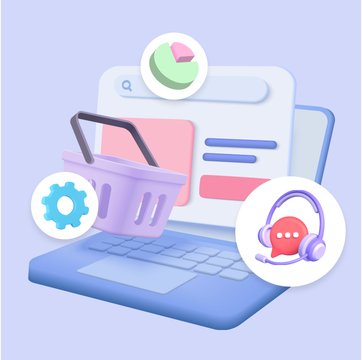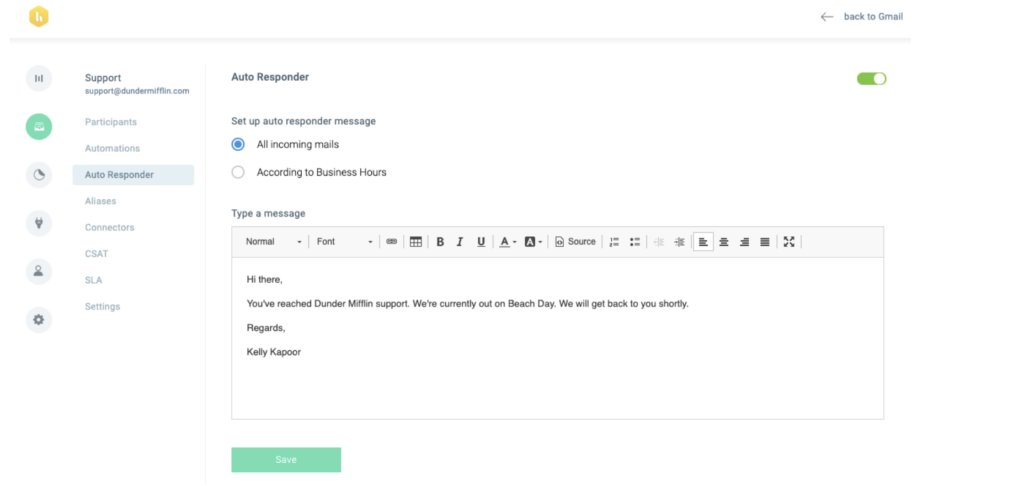How to Write An Automated Email Response: Tips & Examples

Table of contents
Automated email responses are the perfect way to acknowledge the receipt of a message when you’re unable to reply immediately to the sender. Such responses tell the sender that you value their communication and they can be used to communicate important information in your absence.
Automated responses are especially useful when you’re away on vacation, traveling for work or occupied with some other commitment. Basically, any instance where it’s difficult for you to access your shared inbox and respond to emails.
All that being said, automated email responses can come across as robotic and even rude, at times, if not done right.
In this article, we will guide you through the process of crafting well-written automated email responses. We’ll also provide you with practical tips and examples of auto reply emails for different scenarios.
Let’s get started.
Table of Contents
- What is An Automated Email Response?
- Why and When Should We Use Auto-Reply Emails?
- Do’s and Don’ts to Keep In Mind When Sending An Automated Email Response
- 7 Examples of Automated Email Responses
- Wrapping Up
What is An Automated Email Response?
An automated email response, often referred to as an “out-of-office” or “auto-reply” message, is an automatic email message that is generated and sent by your email system in response to incoming emails. It serves as a way to inform the sender that you are temporarily unavailable or unable to respond to their email immediately.
They can vary in complexity, from a simple notification of your absence to more detailed messages with alternative contact information, emergency procedures, or additional information.
You Might Also Like: 119 Email Phrases to Help You Get the Desired Response
Why and When Should We Use Auto-Reply Emails?
Auto-reply emails are a sign of professionalism. They acknowledge the receipt of incoming messages by providing an immediate response. Auto-replies also help manage the expectations of those trying to reach you. To write effortless emails make use of Hiver’s free ai email writer.
Auto-replies inform senders about your current availability or unavailability and provide an estimate of when they can expect a response. This reduces frustration and anxiety on the sender’s side.
Here are some common situations when you should consider using auto-reply emails.
- Vacation or Time Off: When you’re on vacation, taking a day off, or have planned time off work, setting up an auto-reply email informs senders the time period for which you won’t be available. You can also include an alternate contact or provide information about when they can expect a response.
- Business Travel: If you’re away on a business trip, auto-reply messages can let senders know that you’re currently out of the office for a specific reason, such as attending a conference or meeting. Similar to vacation auto-replies, you can include an alternate contact if needed.
- Reduced Work Hours: When you’re working reduced hours or have set specific time intervals for checking your inbox, auto-responders can be used to communicate this information. It helps set expectations regarding response time during those periods.
- Overwhelming Workload: During exceptionally busy times when you might not have the capacity to respond to emails immediately, auto-reply messages can acknowledge receipt of emails and let senders know that you’ll address their message as soon as possible.
- Emergency or Unexpected Absence: In cases of unexpected emergencies or unplanned absences due to illness, auto-replies can inform colleagues and clients about your situation and provide an estimated return date or alternate contacts for urgent matters.
- Testing or Maintenance: When your email system or website is undergoing maintenance or testing, auto-reply messages can notify users of the situation and a time frame on when they can expect normal service to resume.
- Email Address Changes: If you’re changing your email address, you can set up an auto-reply on your old email to inform contacts of your new email address.
You Might Also Like: 23 Email Management Best Practices
Do’s and Don’ts to Keep In Mind When Sending An Automated Email Response
Here are some dos and don’ts to consider when using automated email responses.
1. Do Set Clear Expectations
Clearly communicate the reason for your unavailability and provide an estimated date of your return or when you’ll be able to respond.
Here’s an example:
Hey there,
I’m currently OOO attending a conference and will not be available to respond to emails until 18th January, 2024.
I appreciate your understanding, and I will get back to you as soon as I return.
Best,
Amanda
2. Don’t Overload with Details
The purpose of an automated email response is often to provide quick and concise information. Including too many details might make the recipient skip past critical information such as expected response date.
Recipients may be less likely to engage with or take action on lengthy emails, which can result in missed opportunities or important messages being ignored.
3. Do Include Alternate Contacts
Include contact information for alternative ways to reach you or your team in case of urgent matters. This ensures that important issues can be addressed promptly.
Here’s an example.
Hey,
Thank you for reaching out to us. I’m currently not in office.
However, if this is extremely urgent, please don’t hesitate to contact our support team at [Phone Number] or [Alternative Email Address].
They are available during our regular business hours – [Business Hours]. Your satisfaction is our priority, and we appreciate your patience.
Best,
Amanda
[Job Title]
[Company Name]
4. Don’t Neglect Timely Follow Up
When you return from your absence or have the opportunity to address emails personally again, make it a priority to personally follow-up to the customers .
This ensures that any critical questions or requests raised during your absence are not left unanswered or unresolved. If issues or questions are not addressed promptly, they may escalate into larger problems.
For instance, say a customer emailed you with an urgent request for updates on a project and clarification on the deliverables. However, you are out of office and your automated email response directs the customer to an alternate agent who can handle the request.
Once you return to work it is important to follow up with the customer to ensure that they were able to get all the details they needed. Apart from this, you can also clarify any other queries the customer may have. All of this ensures that your relationship with the customer remains positive and productive.
5. Do Test the Automation
Testing ensures that your automated responses are accurate and provide the intended information or acknowledgment. It helps prevent errors, such as incorrect dates, contact details, or content, which can lead to confusion and miscommunication.
Another reason why you should test out the automation is to ensure that the automated responses trigger at the right time and under the correct circumstances. Testing helps confirm that the automation triggers as expected, whether it’s for out-of-office messages, confirmation receipts, or other scenarios.
6. Don’t Forget to Turn Off Auto-Replies
When you set up an automated email response, such as an out-of-office message or an away notification for vacation, it’s essential to remember to turn it off when you return to work or when the intended purpose is no longer valid.
This is because if you forget to turn it off, recipients may continue to receive automated responses, even when you’re back and able to respond promptly. You might miss important emails or opportunities for timely communication, as senders may assume you’re unavailable based on the automated message.
7. Do Personalize When Possible
If your email automation tool allows it, personalize the message by addressing the recipient by their name and including relevant details, such as their request or inquiry.
Personalized auto-replies tend to capture recipients’ attention more effectively than generic ones. When people feel that the message is specifically tailored to them, they are more likely to engage with it and pay closer attention to the information it contains.
8. Don’t Use Complex Language
Auto replies are meant to convey information concisely and clearly. Complex language can confuse recipients, defeating the purpose of the message.
Jargon-free language ensures that the message is understood by a broad audience, including those who may not be fluent in your language. It makes the message easier to read and digest.
Here are a few examples of simple sentences that you can include in auto-replies.
- Thank You Acknowledgment: “Thank you for your email. We’ve received it and will get back to you shortly.”
- Out-of-Office: “I am currently out of the office and will return on [date]. If you require immediate assistance, please contact [alternate contact information].”
- Order Confirmation: “Thank you for your order. We’ve received it and will send you a confirmation when it ships.”
- Appointment Confirmation: “Your appointment is confirmed for [date and time]. If you need to reschedule or have any questions, please reply to this email.”
- Customer Support: “Our team is here to assist you. Please reply to this email with your questions or concerns, and we’ll respond as soon as possible.”
9. Do Update As Needed
Over time, your contact information, working hours, or other details may change. Keeping your auto replies up-to-date ensures that recipients receive accurate and current information.
In some cases, the content and purpose of your auto replies may need to change to remain relevant to evolving circumstances. For example, during a pandemic lockdown, your out-of-office message might need to include information about remote work arrangements or modified business operations.
Regularly assess the content, contact information, and any other details to make sure they accurately represent your current situation and align with your communication goals.
10. Don’t Use Spammy Language
Many email providers and spam filters are designed to detect and filter out spam language in email messages. If your auto-reply includes spam-like phrases or tactics, it could trigger spam filters, causing your messages to be delivered to recipients’ spam folders or not delivered at all.
Here are some examples of spammy language or tactics you need to avoid in your automated email responses.
- Excessive use of exclamation marks (!!!)
- Overuse of capital letters (FREE, URGENT, ACT NOW)
- Promises of easy money or get-rich-quick schemes
- Phrases like “Urgent Business Proposal,”
- Requests for personal or financial information
- Suspicious-looking URLs or hyperlinks
Instead of using spammy language, keep your auto-replies straightforward and professional – focused on providing the necessary acknowledgment. Be concise, avoid excessive punctuation or hyperbole, and ensure that the message aligns with your organization’s communication standards and values.
7 Examples of Automated Email Responses
Here are a few examples of automated email responses that can be used in different situations.
1. Out of Office Messages
Subject: Out of Office
Hey there,
Thank you for your email. I am currently out of the office and will not be checking my email until [Return Date].
If your matter requires immediate attention, please contact [Alternative Contact Name] at [Alternative Contact Email] or [Alternative Contact Phone Number].
Best regards,
[Your Name]
2. Acknowledgement of Customer Queries
Subject: We’ve Received Your Inquiry
Hello,
Thank you for reaching out to our customer support team. Your request has been received, and we’re working diligently to address it.
You can expect a response within [Response Timeframe]. In the meantime, you can visit our Help Center at [Help Center URL] for answers to common questions.
Best regards,
[Your Name]
[Company Name]
You Might Also Like: 10 Best Practices to Write Customer Service Emails
3. Business Hours Clarification
Subject: Thank You for Your Message
Hey there,
Thank you for reaching out to [Business Name]. We appreciate your interest and value your communication.
Our regular business hours are as follows:
Monday to Friday: [Opening Time] AM/PM to [Closing Time] AM/PM
Saturday and Sunday: Closed
During these hours, we strive to respond to all inquiries promptly.
If your matter is urgent or requires immediate assistance, please don’t hesitate to contact us at [Emergency Contact Number].
For non-urgent inquiries, we kindly ask for your patience, and we’ll get back to you during our business hours.
Thank you for choosing [Your Business Name]. We look forward to assisting you soon.
Best regards,
[Your Name]
[Your Position]
[Business Name]
A tool like Hiver allows you to easily set up auto-responders for emails that are received during both business and non-business hours. This way you can let your recipients know of your availability and when they can expect to receive a response.

You can also include links to your knowledge base software in the auto-responder emails. This helps direct them to FAQs where they might find answers to their queries. Aside from this, you can also include information on how they can contact you in case of an emergency.
4. Event or Webinar Registration
Subject: Thank You for Registering for [Event/Webinar Name]
Hey [Name],
Thank you for registering for [Event/Webinar Name] hosted by [Company Name]. We’re excited to have you join us for this upcoming event.
Event/Webinar Details:
Date: [Event Date]
Time: [Event Time
Location: [Event Location or Online Platform]
Access Information: [Login or Access Details]
Your registration has been successfully received, and you are now officially part of our attendee list.
If you have any questions or require further assistance before the event, please feel free to reach out to us at [Contact Email] or [Contact Phone Number].
In the meantime, make sure to mark your calendar! Look forward to seeing you at [Event Name].
Best regards,
[Your Name]
[Your Position]
[Company Name]
5. Product Inquiries
Subject: Thank You for Your Product Inquiry
Hello,
Thank you for reaching out to [E-commerce Store Name]. We appreciate your interest in our products and the opportunity to assist you.
Your inquiry about [Product Name/Description] has been received, and we’re excited to help you with more information.
Here are the details you requested:
Product Name: [Product Name]
Description: [Product Description]
Price: [Product Price]
Availability: [Product Availability Status]
Shipping Information: [Shipping Details]
Additional Information: [Any Other Relevant Product Information]
If you have any further questions, need additional product recommendations, or require assistance with the ordering process, please don’t hesitate to reach out to us. Our dedicated team is here to provide you with the best possible shopping experience.
Best regards,
[Your Name]
[Your Position]
[E-commerce Store Name]
6. Job Applications
Subject: Acknowledgment of Your Job Application
Hey [Name],
Thank you for your interest in [Company Name]. This is an automated response to confirm that we have received your job application for the [Job Title] position.
We appreciate your time and effort in applying to join our team. Our hiring team will review your application, and if your qualifications match our requirements, we will reach out to you for the next steps in the hiring process.
Please note that due to the volume of applications we receive, we may not be able to respond to each one individually. Rest assured that your application is important to us, and we will carefully consider your qualifications.
Thank you once again for considering a career with [Company Name]. We wish you the best of luck in your job search.
Best regards,
[Your Name]
[Your Position]
[Company Name]
7. Scheduled Down Time
Subject: Notice of Scheduled Downtime
Hey [Name],
Thank you for contacting [Company Name]. We appreciate your inquiry and apologize for any inconvenience, but we are currently experiencing scheduled system maintenance.
During this time, our website and services will be temporarily unavailable. We anticipate that the maintenance will last from [Start Date and Time] to [End Date and Time]. Please note that these times are approximate, and we will do our best to complete the maintenance as quickly as possible.
If you require immediate assistance or have any urgent matters, please don’t hesitate to contact our support team at [Emergency Contact Email] or [Emergency Contact Phone Number]. They will be available to assist you during this period.
We apologize for any inconvenience this may cause and appreciate your patience and understanding as we work to improve our services.
Best regards,
[Your Name]
[Your Position]
[Company Name]
Wrapping Up
Crafting automated email responses is a valuable skill for efficient communication. With the tips and examples provided, you’re well-equipped to create effective auto-responders that help acknowledge incoming emails, and set the right expectations with internal and external stakeholders.
Automation is key here because it can help you save a lot of time and effort in acknowledging incoming emails.
Hiver, for instance, provides several robust automation capabilities that can streamline your workflow and cut down repetitive everyday tasks. This way your team doesn’t have to worry about routine tasks. Instead, they can focus on building relationships with customers and going the extra mile for them.
If you’d like to know more about how Hiver can help your business, do sign up for our free 7 day trial to learn more!

































